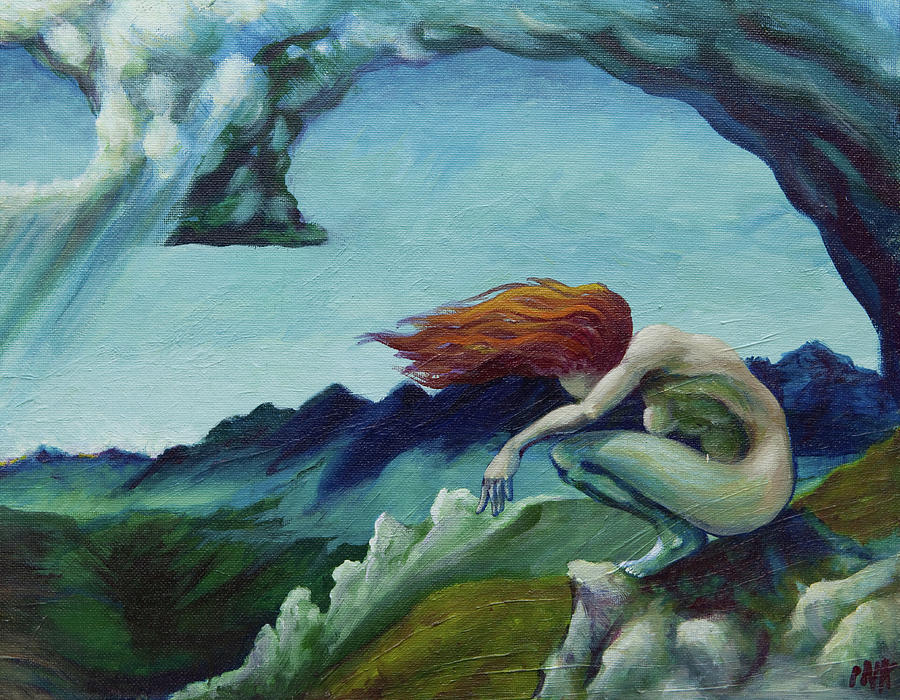water colour
The haunting tune
of monsoon,
an old craving sprouts from beneath the mulch ,
the rain sodden memories
like dense ponderous clouds
of a far away land,
inch closer and closer,
then burst and collapse.
I breathe in the moisture of the air .
I look out
and see the intriguing wet darkness ,
my desolate lane
the blurred light of the street lamp
and the sharp arrows of rain creating a water colour ,
beautiful yet plaintive.
A face is overlapped by another
and yet another ...
and all these faces are mine ,
brush strokes of unspoken words ,
the smudged hues of their pain
painting the contours
of my desires,
and erasing them
again.

Monsoon -- Ida Kendall
The English term “monsoon” was first used in British India (India, Bangladesh and Pakistan) and neighboring countries to refer to the big seasonal winds blowing from the Bay of Bengal and the Arabian Sea in the southwest that bring heavy rainfall to the area. It is traditionally defined as a seasonal reversing wind accompanied by corresponding changes in precipitation but is now used to describe seasonal changes in atmospheric circulation and precipitation associated with the asymmetric heating of land and sea. It is described as a large-scale sea breeze which occurs when the temperature on land is significantly warmer or cooler than the temperature of the ocean because water and land absorb heat in different ways: Over oceans the air temperature remains relatively stable because water has a relatively high heat capacity and because conduction and convection both equilibrate a hot or cold surface with deeper water, while dirt, sand, and rocks have lower heat capacities and can only transmit heat into the earth by conduction and not by convection -- therefore, bodies of water stay at a more even temperature, while land temperature are more variable. “Monsoon” is usually used to refer to the rainy phase of a seasonally changing pattern, although technically there is also a dry phase. Just as there is some disagreement over what it is, its etymology is also unclear; it may be derived from the Arabic "mawsim" (season) [from “wasama,” to mark] or the Hindi "mausam" (weather, climate) and evolved into the Portuguese “monção” and the Dutch “monssoen” before being adopted by the English. Several geographically distributed monsoons exist, but the South Asian one is among the world’s most anticipated weather phenomena and is an economically important pattern every year from June through September, though it is only partly understood and notoriously difficult to predict. Several theories have been proposed to explain the origin, process, strength, variability, distribution, and general vagaries of the monsoon, but understanding and predictability are still evolving. The geographical features of the Indian subcontinent, along with associated atmospheric, oceanic, and geophysical factors, influence the behavior of the monsoon. It has such a significant effect on the overall well-being of residents, agriculture, and climate that it has been dubbed the "real finance minister of India." In some places there is only a little more (or less) rain, but in others semi-deserts are turned into vivid green grasslands where all sorts of plants and crops can flourish. Its onset occurs over the Bay of Bengal in May and reaches the Indian Peninsula by June before the winds move towards the South China Sea; by early September it begins a gradual withdrawal, and by mid-October it is completely gone from the northern half of the peninsula; the withdrawal takes place progressively from north to south until the first week of January, the start of the winter season. (The retreating monsoon winds move over the Arabian Sea and the Bay of Bengal, collecting moisture on the way, and produce a second round of rainfall, the so-called winter monsoons in the southern states of Karnataka, Tamil Nadu, Kerala, and Andhra Pradesh in the first week of January. The “bursting” of the monsoon refers to the sudden change in weather conditions (typically from hot, dry weather to wet, humid weather), characterized by an abrupt rise in the mean daily rainfall; its erratic nature is often referred to as “vagaries.”
ReplyDeleteA wonderful piece of work Mallika di. Absolutely brilliant.Congratulations!
ReplyDeleteThank you very much Ronald . 😊
DeleteBeautiful poem.
ReplyDelete